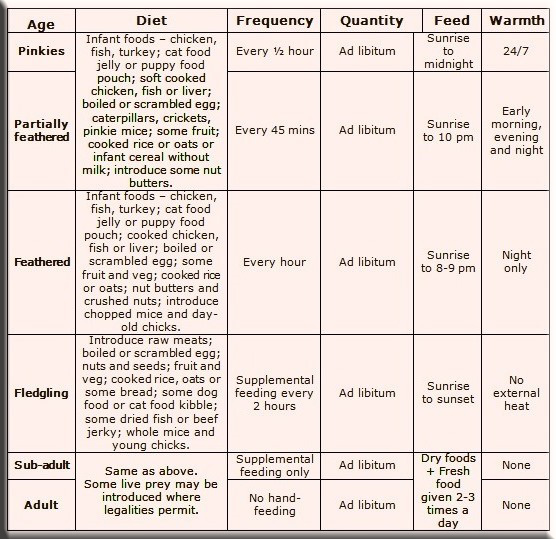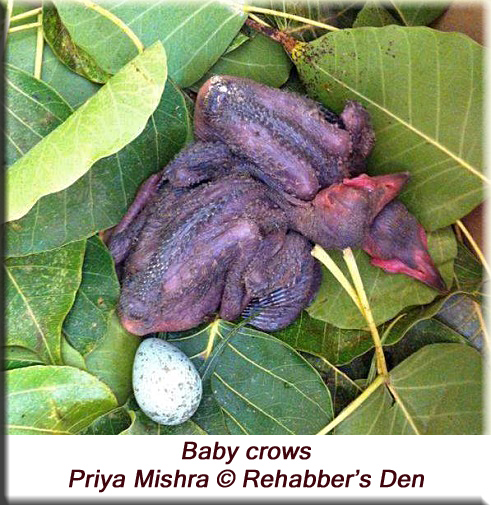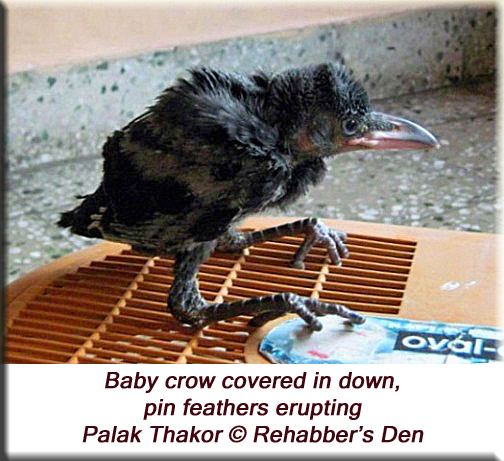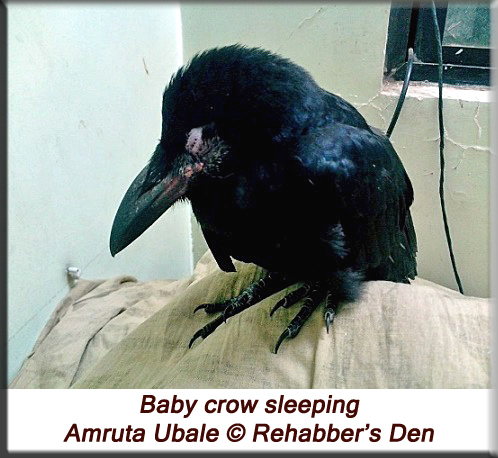Hand-rearing and rehabilitation of corvids: House crow and Jungle crow, continued
Devna Arora
Link to Page 1: general guidelines
Hand-Rearing Corvids: Summary of Care

Stage-wise care of corvid chicks
Stage 1: Nestling – unfeathered

Characteristics: Baby crows are born completely naked with their eyes closed and are completely dependent on their parents for warmth, food and care. Thermoregulation is poorly developed in new-born chicks and they require a source of external heat at all times. The chicks’ eyes open by the time they are 7-10 days old. At the same time, the first pin feathers and insulating down feathers erupt and rapidly cover the chick in a small layer of feathers.
Feed: The chicks are extremely delicate at this stage and must only be fed soft-cooked and easily digestible, mashed foods. Chicks require a protein-rich diet at this stage comprising of 40-50% animal-based proteins. Half of the chick’s diet will comprise of soft boiled or scrambled egg, infant (human) baby foods – chicken, fish, baby beef or turkey; puppy or cat food pouches; soft boiled chicken, liver and fish (deboned); some green caterpillars (do NOT use any hairy caterpillars as they can be extremely toxic) or grasshoppers (preferably after the second week). The remaining diet can comprise of infant cereal like Nestum which is without milk (can be used as a formula or rolled into a soft dough), cooked rice or oats, some dough made of sattu and some soft fruits like banana, and home-made nut butters (without salt/sugar) using sesame seeds (a personal favourite as its rich in calcium), peanuts and cashew nuts.
Once the chicks have settled and are accepting the feed well, a drop of vitamin and calcium drops must be added to at least 2 feeds a day to begin with and gradually increasing to 2 drops in 3 feeds of the day by the end of the second week. Probiotic supplements too may be added as per the chick’s requirements – a pinch of powder added to 3-4 feeds should be adequate for a chick at this age.
The chicks do not require any additional water at this stage as they get the required amount through their feed. [Please refer to note on ‘Water and Hydration on the previous page for further details.]
Feeding quantity and frequency: Feeding must begin at sunrise and continued till about 10-11 pm in the first couple of weeks of the chick’s life. The chicks must be fed every half hour and must be given as much as they will readily have. Once the chick has had enough, it will refuse to gape and feeding must be stopped. Over-feeding must always be avoided.
As a guideline, a new-born baby would consume roughly 1 ml of food per feed, a week-old baby would consume 2-3 ml or a teaspoon per feed, while a 2-week old baby would consume 5-6 ml or a tablespoon per feed.

Special care: Naked nestlings require additional warmth throughout the day even when housed at room temperatures. The surrounding temperature must be maintained at approximately 100˚F for the first couple of weeks of the chick’s life.
As their skin is very tender, they must be kept on soft bedding – a lining of soft cotton cloth will be preferable to tissues/paper towels at this stage. Refrain from using cotton wool, fleece or Turkish cotton towels.
Stage 2: Nestling – feathered
.jpg)
Characteristics: The chicks are adequately feathered, covering the bulk of the body, by the time they are three weeks old. The eyes are noticeably blue at this young age while the pink beak begins to darken in colour. Colour markings, indicative of the species, become visible at this stage. The chicks become active and strong by this stage and begin standing on their legs in a few weeks’ time. They also now begin to respond to sounds and movements around them and begin to show recognition.
.jpg)
Feed: TThe chicks are given a similar diet at this stage but do not require soft cooked or mashed foods any longer. Their diet must still be protein-rich and must comprise of a minimum of 40% of animal-based proteins. The chick’s diet can now comprise of boiled or scrambled egg, infant (human) baby foods – chicken, fish, baby beef or turkey; puppy or cat food pouches; boiled chicken, liver and fish (deboned) and raw meats must be slowly introduced as the chicks age; some green caterpillars or grasshoppers. The remaining half of the diet can comprise of a combination of cooked rice or oats, some chapattis, some dough made of sattu and a little bit of all fruits. Vegetables, sprouted lentils, nuts and seeds must also be introduced at this stage – mostly shelled and crushed initially but introduce whole (and with shells) seeds and nuts gradually. Fresh drinking water must now be provided in a bowl for the baby birds.
2-3 drops of vitamin drops and calcium drops must be added to three feeds daily. Probiotics too may be added if required – a pinch of probiotics thrice a day would suffice each chick.
Feeding quantity and frequency: The chicks may now be fed every 45 minutes until they are a month old and then every hour until fledging as they will now be able to consume larger quantities in one go. Babies should consume 1-2 tablespoons of food per feed. Feeding must begin by sunrise and continued until sunset or an hour or so later.

Special care: Thermoregulation also develops by this age and as the chicks are now also feathered, they retain heat a lot better. External heat may be discontinued in the mid-mornings and afternoons [esp. on warmer days or depending upon the environmental conditions where you live] in the 3rd week and completely discontinued during the day once the chicks are a month-old. The chicks will still require some warmth at night until they fledge. The surrounding temperature can be maintained at approximately 98-100˚F until fledging.
Stage 3: Fledgling – dependent upon parents
Characteristics: Chicks fledge at the age of about 6-8 weeks in captivity. Newly fledged chicks have a visible pink gape flange and although their feathers appear fresh, they are duller in plumage than adult birds. Baby birds stay close to their parents at this stage and do not range much further away from the nesting site. The chicks are able to eat on their own by the time they are a month-old but continue to beg and require supplemental hand-feeding until 2-3 months of age.
Feed: Baby foods and puppy/cat food pouches may be completely discontinued at this stage. The young birds will instead be consuming raw meats – chicken, fish, mice, chicks (poultry), etc. Since crows are highly opportunistic in nature, live mice and chicks may be given occasionally as hunting practice for the young birds (where possible and legally permitted). They may be given dog or cat food kibble and are particularly attracted to multi-coloured foods. Diet will also include cereals, nuts, seeds, fruits and vegetables. Diet must also include some human foods since the birds will likely often scavenge for left-overs. The birds must always have a bowl of fresh drinking water.
Feeding enrichment must begin at this stage and the young birds must be given a complex of foods that require both skill and mental expertise to acquire. Food must also be placed in several different places at different times of the day to encourage the birds to search for food.
Feeding quantity and frequency: Dry foods must be available at all times for the young birds and a plate of fresh foods must be given to the chicks about 3-4 times a day. To encourage eating on their own, offer a plate of chopped foods and draw the chick’s attention to it by tapping on the place and giving them a few morsels from the plate. Every time the chicks beg, offer a plate of food instead of hand-feeding them – they learn to pick up pieces of food faster this way. Intermittent hand-feeding must be continued for about a month after fledging until the chicks are consuming adequate quantities themselves but will have completely ceased by the time the chicks are 2½ - 3 months of age. The chicks must also be offered whole fruits (i.e., complete with the skin) so they can learn to eat foods as they are found in nature.
Special care: The chicks must be shifted to an aviary at this stage as they need flight practice before release. Although they do not require external heat anymore, the aviaries must have a nest box or some sheltered space that cuts off the breeze as the chicks may still prefer a warmer space for the night. Alternatively, they may be shifted indoors for the night for the first couple of weeks after fledging. The aviaries must have large trees so the chicks get habituated to sleeping under covered branches.
Stage 4: Fledgling – independent
Young crows start becoming independent by the time they are 4-5 months of age and require minimal intervention and looking after thereafter. They must have gone through active rehabilitation after fledging and the soft release process must have now begun. If opting for a hard release (not advisable as hand-reared crows are likely to fare better with a soft release), they can be released after 5-6 months of age.
Feeding: The chicks will consume a similar diet as in the previous stage but hand-feeding will have completely ceased. Dry food and water must be available for them at all times with fresh foods provided 2-3 times/day.
Special care: The chicks are now completely independent and must be readied for release. If they were shifted to smaller enclosures at the time of fledging, they must now be in larger aviaries for adequate flight exercise prior to release.
Rehabilitation and Release
Important considerations when rehabilitating young crows:
1. Space
Crows are large sized birds and require more space than the average passerine for adequate flight practice. Although babies may be hand-reared at home, they must ideally be shifted to larger outdoor aviaries for at least a couple of months prior to release.
Young crows may be shifted to smaller enclosures by the time they are 5-6 weeks old. Even if they haven’t fledged yet, they are quite adept on their feet and can begin exploring their space. Perches must be closely connected so the babies can climb with ease, yet none must be very high to prevent physical injuries from falling off. Once the birds fledge, higher perches must be offered to encourage the birds to hop between higher branches.
By the time the birds are 2 - 2 ½ months old, they must be shifted to a larger aviary of at least 12 ft. X 30 ft. and 12-15 feet high. The aviary must have at least a couple of tress so that the young birds get accustomed to sleeping under tree cover. Tress must be placed towards the edges of the aviary so as to leave adequate flying space for the birds. Although the young birds will prefer to sleep in the open, there must always be a couple of nest boxes in case the birds prefer to use them.
2. Independence
This is a very important criterion for all hand-raised babies. All baby animals naturally come to depend upon their caregivers but when being hand-reared, it is important to minimize (and gradually wean off) human contact as soon as the birds become independent. Crows in the wild very well communicate with humans, in fact, many have their feeding rituals and readily take food from the hands of the people they recognize so handling is definitely not detrimental but they tend to tune in to their instincts better when human handling is minimal.
The young birds begin feeding on their own nearing fledging age. Supplemental hand-feeding may be continued for a few weeks after fledging to ensure intake of nutrition and adequate weight gain but hand-feeding must have completely ceased by the time they are 2 ½ - 3 months old. Handling too would be unessential at this stage and the birds must not get habituated to begging or demanding attention from humans.
3. Enrichment
CCrows are very intelligent birds and require great amounts of stimulation to keep them occupied and to encourage them to investigate new spaces and things. They must be provided lots of toys and puzzles (some can easily be picked up at pet shops and food puzzles designed for dogs and cats may very well be appropriate for crows), food games and natural whole foods that require time, skill and expertise to obtain. The process of enrichment is gradual – introduce simpler puzzles and food games to begin with and gradually introduce complex puzzles. For example, if introducing whole groundnuts – the birds at first may have no idea what it is or what they are supposed to do with it so it will be a good idea to give them partially shelled nuts before introducing whole groundnuts.
Food must also not be offered only in one place, at a specific height or even at a particular time. The birds must not be habituated to expecting anything. They have to learn to be opportunistic and actively look for opportunities to gain. Hide foods in different puzzles, in different places and at different times of the day.
Crows are particularly sensitive to changes in the spatial gradient and may even stop eating when in unfamiliar and new places or conditions. It is therefore very important to prevent them from getting used to a particular surrounding (as this will be problematic at the time of release) and to continually make some changes to their living arrangements – this not only ensures that the birds have adequate enrichment but also that they remain adaptable to new living conditions and adjust better, with minimal stress, to the changes in their environment.
4. Socialization
Corvids are very social birds and the majority of their learning is learned through interaction (and correction) with other birds. It is very important for the young birds to be raised in the company of other young birds or be raised in close proximity to other (and preferably wild) birds. Where direct interaction may not be feasible (no other corvids in captivity) or beneficial (if the older birds are specifically attacking or harassing the younger birds), they may be placed in adjacent enclosures or rehabilitated through in-situ acclimatization. Different species of corvids may very well be housed and raised together as their range often overlaps in nature.
5. De-worming prior to release
Please refer to note on previous page.
6. Acclimatization and Release
Since crows are highly sensitive to spatial changes, they fare best when released through a soft release process with in-situ acclimatization. Acclimatization is a process where an animal is allowed to become familiar with the intended place of release for at least a couple of weeks prior to release – this is typically done at the intended site of release. Unlike most other birds, crows tend to return closer to their nesting site until they are old enough to move away and such a release process gives them the security to do just that.
Ideally, young crows must be shifted to an in-situ aviary upon fledging and the aviary can be opened when the birds are 4-5 months old. Younger birds tend to get bullied by resident corvids and it is best to begin their release process only after 4 months of age. They may also be rehabilitated from home, in which case, their living arrangements must ideally be made in a large balcony or terrace which can be covered with net or wire (chicken wire is affordable and it works just fine) to prevent the birds from escaping while they are being hand-raised – this can be taken down at the time of release.
N.B. Being large birds, they benefit from the open space of an aviary and do not get adequate flying practice at home so I will not encourage you to keep the birds at home, rather, shift them to a rehabilitation centre prior to release. The species is also not shy in nature and readily approaches humans for treats. Birds that are habituated to living in the house might easily enter someone else’s house after release – getting trapped or possibly flying into the ceiling fan resulting into disastrous consequences.
At four months of age, the aviary can be opened for the birds, allowing them to fly in-and-out at free will. They must initially be provided food both inside the aviary and outside, gradually shifting their feeding trays outside over the following two weeks. The young birds continue to return for treats and often to sleep at night until they are 5-6 months of age. Once completely independent, they will likely cease to return at night but may occasionally visit for treats. The aviary can then be used for the next lot of youngsters.
Photographs used (available online)
Priya Mishra – Baby crows
Available from:
https://www.facebook.com/tuktuk19may/media_set?set=a.10150174014437949.310892.664612948&type=1
Tejas Katdare – House crow feeding its chicks
Available from:
https://www.flickr.com/photos/tejas_katdare/4879017576
Acknowledgements
I’d like to extend a sincere thanks to Palak Thakor for his wonderful documentation of the house crow chicks and sharing his hand-rearing notes with me. Palak, I sincerely hope we are able to work on more protocols together in the future.
I’d like to extend a big thanks to Tejas Katdare, Priya Mishra and Amruta Ubale for sharing their photographs with me and giving me the permission to use them. Here’s another big thanks to Sujaya and Arpna for beautifully capturing the pics of the baby crow we reunited and the Menon family for looking after him until we put him back in his nest! [An account of the reunion is available on our stories page with more photographs.] Thanks a bunch guys, your photographs truly add value to words!
References
Baker, E.C.S. (1922) The Fauna of British India, including Ceylon and Burma: Birds – Vol. I (2nd Ed.), Taylor and Francis, London. Pp. 25-28; 33-34.
Bourne, D. (undated) Hand-rearing of Crows, Jay, Mapgpie, etc.
Available from:
http://wildpro.twycrosszoo.org/S/00Man/AvianHusbandryTechniques/
UKBHusbIndTech/HR_Av_Corvids.htm [Accessed: 04/04/2014]
Corvid Aid (undated) Feeding. Available from: http://www.corvidaid.org/care-guide/feeding/ [Accessed: 04/04/2014]
Fox, T. (2003) Corvid Husbandry and Management. Available from: http://www.riverbanks.org/subsite/pact/corvids.pdf [Accessed: 26/08/2012]
Gage, L. J. and Duerr, R. S. (2007) Hand-rearing birds. Blackwell Publishing, Iowa, USA.
Heather (2012) Hand-rearing a raven chick. Available from: http://www.birdtricks.com/blog/hand-rearing-a-raven-chick/ [Accessed: 04/04/2014]
McGowan, K. J. (undated) I found a baby crow that must have fallen from the nest/been abandoned/is injured! Available from: http://www.birds.cornell.edu/crows/babycrow.htm [Accessed: 10/04/2014]
Oates, E.W. (1890) The Fauna of British India, including Ceylon and Burma: Birds – Vol. II, Taylor and Francis, London. Pp.17-18; 20-21.
Stocker, L. (2005) Practical wildlife care (Second Ed.). Blackwell Publishing.
Whitmore, K. D. and Marzluff, J. M. (1998) Hand-rearing corvids for reintroduction: Importance of feeding regime, nestling growth, and dominance. Journal of Wildlife Management 62(4):1460-1479. Available from:
http://www.sefs.washington.edu/research.acl/Crows_and_Other_Co
rvids/whitmore_marzluff_handrearing.pdf [Accessed: 04/04/2014]
Please note: This document is targeted at hand-rearing alone and does not address or substitute any veterinary procedures. For any medical concerns, please consult your veterinarian at the earliest.
For amateurs or people handling new born chicks for the very first time, please keep in touch with a trained and experienced hand for guidance and regular progress updates.
Protocol published in 2014





